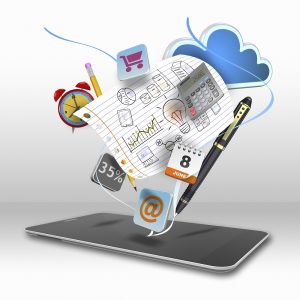It is early Saturday morning. Very quiet. Kids are still sleeping. Sun is slowly rising and the air is magically yellow, the kind of morning glow you only get in October when the leaves are slowly turning. I love this time of the year, this time of the day, this time of the week when there is time enough to enjoy your extra-large cup of black, fresh brewed, strong coffee. I am browsing through my social media apps. My very personalized feeds quickly make sure I am up to date with what my closest network of friends and family are up to. I spend some time on Pinterest. We are renovating our bathroom and I am looking for some interior ideas. I save some pins especially suggested for me. Very close to how I would like my bathroom to look. How come they know?
Back to reality and some more urgent issues…, dinner guests tonight. What would be a nice menu for our new very cosmopolitan friends? I would really like to make a nice impression, but at the same time I would like to go with a relatively safe card. My newly discovered app “What’s cooking” mysteriously seem to know exactly what would be perfect for this Saturday night. I save the suggested grocery list and forward it to my husband.
Time flies, a new season is upcoming. I would certainly need some new pieces in my wardrobe. And so do the kids. I open my personal shopper app. A cute blouse… exactly what I need. Spot on recommendation. Matches perfectly what I bought a couple of weeks ago. Amazing. I find some wonderful kids clothing too… Done. I few clicks later it is all payed for and on its way to me.
We plan to go down town Stockholm a little later today. My very efficient morning frees up time for some shopping of the more cozy kind. Weekend flowers, some delis for tonight and a longer coffee break instead of sweating in the dressing room of a crowded store. I feel all planned and ready when the kids wake up. Time to take the oldest daughter to her dance class. Heavy traffic on the way there. It would have ended in a missed class and devastated daughter if it wasn’t for my smart GPS app. It conveniently helps me find the best alternative route, and then directs me to the best free parking spot, probably using image detection, my analyst brain adds quietly….
Machine learning. It is everywhere. It is part of our daily life even though we might not even notice it. Optimizing and personalizing our surfing experience, proposing interior, dinner ideas, shopping, routes, and free parking spots. Making life a bit easier. And smarter.
What is Machine learning?
Machine learning is the automation of discovery. It automates the development of a system that by itself constantly learns to find new patterns, relationships and facts in data. Pedro Domingo put it nicely in his book The Master Algorithm: The algorithms learn from the trails of data we leave in our newly digital world. Like curious children, they observe us, imitate, and experiment.
Considering the amount of articles and headlines recently published on the subject, one might think that we just invented something new. But machine learning is not new. The first algorithms were proposed more than 50 years ago. What is new is the context around us: increased amounts of data, virtually unlimited opportunities for data storage and computing power, as well as a common infrastructure for all people, organizations and companies. Together these factors all of a sudden makes machine learning a pretty obvious tool for more and more tasks.
The absolutely largest difference in circumstances between then and now is the wealth of data to learn from. Space is big. You just won’t believe how vastly, hugely, mind-bogglingly big it is. I know Douglas Adams was not referring to data when he wrote this, but it pops up in my mind as a nice description of today’s massive data load. We produce huge amounts of data every day. Around 90 % of the data we have today didn’t exist two years ago. Internet of things, social media and advancement in imaging/video technology, have accelerated the generation of data. We produce data wherever we go. When it comes to machine learning data is the key. Some techniques such as deep learning performs at its best with millions and millions of training examples.
A big portion of today’s data – some references states as much as 90 % of all data – is unstructured – e.g. pictures, text voice video. Nowadays we can, with machine learning techniques, transform unstructured data to structured data, so that we can combine them we other structured data and include this large portion of data to enhance our models and reports. The value of this information to organizations is vast.
More and more organizations are starting to discover the tremendous benefits of machine learning. Those of you who know Swedish can read more about how machine learning and especially deep learning can make your organization smarter in my recent article written for CFO World.
What is what, and what is the difference?
With the hype around the subject comes a large confusion. I often meet customers, and also colleagues, who are confused with what is what. They ask me questions like: Do you do artificial intelligence as well (as machine learning)? What is the difference between machine learning and deep learning? What about cognitive computing, isn’t that the same as artificial intelligence? In the same context as machine learning we often hear terms like e.g. artificial intelligence, deep learning, and cognitive computing. Sometimes they are used interchangeable and sometimes they are used as if they were totally different things. What is what and how do they differ? Do they differ? We could indeed benefit from a clear explanation. So, here we go:
I would like to think of artificial intelligence as the big umbrella in a way. It is the broadest term. Including everything that enables computers to mimic human intelligence. So simple if-then rules could be artificial intelligence, but also machine learning and deep learning. With that said machine learning is a subset of artificial intelligence. Deep learning is then a subset of machine learning. Cognitive computing comprises them all. It is basically artificial intelligence (including its subfield machine learning, and in particular deep learning) together with natural language processing. Cognitive computing enables interactions between man and machine. A cognitive system understands input like text, speech, pictures and video, it can reason and transform input to analytical actions and create an output consumable by humans.
So deep learning is a subset of a subset. A very interesting subset though that holds amazing promises and interesting applications. In a next blog post, I will discuss more around deep learning – what it is and what it holds. Since it was Halloween recently, I would like to finish up by referring to a pretty cool application of deep learning related to just that. MIT researchers has just in time for Halloween, taught machines how to scare us. Their Nightmare Machine uses deep learning to turn ordinary images into terrifying representations. Check it out and be afraid. Stay tuned.


